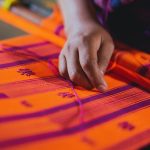Coincidentally, you're about to delve into the world of fabric projects, and you're contemplating the ideal elastic for your creations. Is braided elastic the best choice for your fabric projects?
As you navigate the intricate realm of sewing and crafting, it's crucial to understand the ins and outs of different elastic types. From its unique structure to its distinct advantages and potential limitations, braided elastic offers a wealth of possibilities for your projects.
In this brief exploration, we'll delve into the characteristics of braided elastic, weigh its pros and cons, and provide insightful tips for its use. By the end, you'll have the expertise to determine if braided elastic is the perfect match for your fabric endeavors.
Key Takeaways
- Braided elastic is a durable and resilient option for fabric projects, maintaining its stretch over time.
- It is versatile and suitable for various fabric types and clothing elements, including waistbands, sleeves, and leg openings.
- However, it may not be suitable for heavier or denser materials and requires careful evaluation of elastic durability and fabric compatibility.
- When using braided elastic, it is important to choose the appropriate width, secure the ends before sewing, maintain proper tension while sewing, and stretch the elastic as you sew to match the length of the fabric.
Understanding Braided Elastic
If you're new to sewing, understanding braided elastic is essential for choosing the right material for your fabric projects. Braided elastic is a popular choice due to its durability and shape retention. It's important to grasp the elasticity properties of this material.
Braided elastic is constructed by weaving multiple strands of rubber or spandex, creating a strong and resilient elastic. This design allows it to maintain its stretch over time, making it ideal for waistbands, sleeves, and leg openings. It's crucial to note that braided elastic isn't suitable for direct exposure to sunlight or high heat, as it can degrade the elastic properties.
When comparing elastic materials, braided elastic stands out for its ability to withstand repeated stretching and recovery. Its woven construction provides a high degree of resilience, making it an excellent choice for garments that require frequent movement.
In contrast, knitted elastics are softer and more comfortable against the skin, but may not offer the same level of durability. Understanding these differences empowers you to select the most suitable elastic for your sewing projects.
Pros of Braided Elastic
To fully appreciate the advantages of braided elastic, consider its exceptional durability and reliable stretch, making it a top choice for various fabric projects. The pros of braided elastic are evident in its versatility, durability, and ease of care. Take a look at the table below to understand the strengths of braided elastic:
| Pros | Description |
|---|---|
| Versatility | Suitable for various fabric types and can be used in waistbands, sleeves, and other clothing elements |
| Durability | Resistant to wear and tear, ensuring longevity in your fabric projects |
| Easy Maintenance | Can be machine washed and dried without losing its elasticity, making it convenient to care for |
Braided elastic's versatility makes it suitable for different fabric types and applications, from lightweight garments to heavy-duty fabrics. Its durability ensures that it can withstand repeated stretching and recover its original shape, making it a reliable choice for long-lasting fabric projects. Additionally, its easy maintenance allows for hassle-free care, as it can be machine washed and dried without losing its elasticity. With these benefits, braided elastic proves to be an excellent option for a wide range of fabric projects.
Cons of Braided Elastic
When considering braided elastic for your fabric projects, be mindful of its potential for weakened elasticity over time, particularly with frequent use and exposure to heat. Elastic durability is a crucial factor to consider, as braided elastic may lose its stretchiness over time, leading to a less secure fit in your fabric projects. This can be especially concerning for items that require consistent elasticity, such as waistbands or fitted sleeves.
Another important consideration is fabric compatibility. While braided elastic is suitable for many fabrics, it may not be the best choice for heavier or denser materials. The tension of the braided elastic may not be sufficient to provide the necessary support for these fabrics, leading to a lack of effectiveness in the finished product.
Understanding the potential cons of braided elastic allows you to make informed decisions when selecting materials for your fabric projects. By carefully evaluating elastic durability and fabric compatibility, you can ensure that your creations maintain their quality and functionality over time.
Types of Fabric Projects Suitable for Braided Elastic
If you're looking to add elastic to your fabric projects, braided elastic is a fantastic choice for a variety of reasons.
It's versatile and can be used in a wide range of projects, from waistbands to sleeves, making it a go-to option for many sewing enthusiasts.
Additionally, its ability to provide a snug fit makes it ideal for creating fitted garments that require flexibility and comfort.
Versatile for Various Projects
You can use braided elastic for securing the waistbands of skirts, pants, and shorts with ease. Its elastic strength makes it suitable for a variety of fabric projects.
Here are five types of fabric projects that are suitable for braided elastic:
- Crafting comfortable and adjustable waistbands for children's clothing
- Creating form-fitting cuffs for sleeves and pant legs
- Designing stretchy and secure closures for face masks
- Adding flexibility and comfort to undergarments such as underwear and bras
- Customizing fitted sheets and bed linens for a snug and adjustable fit
Braided elastic is a versatile option for these fabric projects due to its durability and stretchability. Mastering sewing techniques with braided elastic can elevate your fabric projects, providing both function and comfort.
Ideal for Fitted Garments
Crafting form-fitting cuffs for sleeves and pant legs is an ideal fabric project suitable for braided elastic. When working on fitted garments, the choice of elastic is crucial for achieving the perfect fit.
Braided elastic is versatile and well-suited for this purpose due to its ability to stretch and recover without losing elasticity over time. The unique construction of braided elastic allows it to conform to the body's movements, making it an excellent choice for projects that require a snug and comfortable fit.
Whether you're sewing leggings, swimwear, or fitted tops, braided elastic ensures that the garment moves with the body while maintaining its shape. Its durability and stretchiness make it an ideal option for various fitted garment projects, providing the necessary support without sacrificing comfort.
Tips for Using Braided Elastic
Start by measuring the length of braided elastic needed for your project and cut it with sharp scissors to prevent fraying.
- Choose the Right Width: Select the appropriate width of braided elastic for your project. A wider elastic is best for heavy fabrics and waistbands, while a narrower one works well for sleeves and other smaller openings.
- Secure the Ends: Before sewing the elastic into your project, secure the ends with pins or a zigzag stitch to prevent twisting or bunching.
- Use Proper Elastic Tension: When sewing the elastic onto the fabric, maintain a slight tension on the elastic to ensure a snug fit without causing it to pucker or gather.
- Stretch as You Sew: While sewing the elastic onto the fabric, gently stretch it to match the length of the fabric, distributing the elastic evenly as you sew.
- Test the Fit: Once the elastic is attached, check the fit by stretching the fabric to ensure it's comfortable and allows for movement. Adjust the tension if needed.
Comparing Braided Elastic With Other Elastic Types
When it comes to elastic for your fabric projects, understanding the differences between braided and knitted elastic is crucial. You'll want to consider the durability and stretch of the elastic, as well as how it will work with different types of fabrics.
Braided elastic is made by weaving multiple strands of rubber or latex together, creating a durable and firm elastic. It has a slightly rough texture and is known for its resilience and strength. Braided elastic is ideal for heavy-duty applications and projects that require a lot of stretch and recovery. It works well with fabrics that are thick or have a lot of weight, such as denim or upholstery materials.
On the other hand, knitted elastic is made by interlocking fibers to create a softer and more lightweight elastic. It has a smooth texture and provides a gentle and comfortable stretch. Knitted elastic is best suited for lightweight fabrics or garments that require a softer touch, such as lingerie or children's clothing. It is also great for applications where a narrow elastic is needed, such as waistbands or sleeve cuffs.
Braided Vs Knitted Elastic
When choosing elastic for your fabric projects, consider the differences between braided and knitted elastic to determine the best option for your specific needs.
Braided elastic is known for its excellent stretchability, making it suitable for various fabric types. It offers great stretchability and has excellent shape retention. It is also more durable and less likely to lose its elasticity over time.
On the other hand, knitted elastic provides a gentle stretch, making it ideal for waistbands and leg bands. It is softer against the skin, making it perfect for undergarments and lingerie.
Both braided and knitted elastic have unique material properties that affect their performance in different fabric projects. Here are some key points to consider:
- Braided elastic offers great stretchability and has excellent shape retention.
- Knitted elastic provides a gentle stretch, making it ideal for waistbands and leg bands.
- Braided elastic is more durable and less likely to lose its elasticity over time.
- Knitted elastic is softer against the skin, making it perfect for undergarments and lingerie.
Elastic Durability and Stretch
To evaluate the elastic durability and stretch, compare braided elastic with other elastic types to determine the most suitable option for your fabric projects. When comparing braided elastic with knitted, woven, and rubber elastic, it's essential to consider elastic strength and applications. Here's a comparison table to help you make an informed decision:
| Elastic Type | Elastic Strength | Elastic Stretch | Common Applications |
|---|---|---|---|
| Braided | High | Moderate | Waistbands, sleeves |
| Knitted | Moderate | High | Cuffs, waistbands |
| Woven | Low | Low | Light-duty uses |
| Rubber | High | High | Swimwear, sportswear |
Understanding the elastic strength and stretch of each type will guide your choice based on the specific requirements of your fabric projects.
Elastic for Different Fabrics
You frequently need to consider the compatibility of braided elastic with various fabric types when deciding on the most suitable option for your fabric projects. When it comes to elastic for swimwear, choosing the right width is crucial for achieving a secure and comfortable fit. Here are some key points to consider when comparing braided elastic with other elastic types:
- Fabric Compatibility: Braided elastic works well with a wide range of fabrics, including swimwear materials like nylon and spandex.
- Stretch Requirements: Assess the level of stretch needed for the specific fabric to ensure the elastic will provide the right amount of give.
- Durability: Consider the durability of the elastic in relation to the fabric's intended use and care requirements.
- Width Selection: Different fabrics may require varying widths of elastic to achieve the desired support and fit.
- Moisture Resistance: For swimwear, opt for elastic that's resistant to damage from moisture and chlorine exposure.
Care and Maintenance of Braided Elastic
For proper care and maintenance of braided elastic, regularly check for signs of wear and tear to ensure its durability and longevity.
When caring for braided elastic, it's essential to consider the fabric compatibility and stretching capabilities. Always refer to the washing instructions provided by the manufacturer to maintain the elasticity and fabric suitability.
To prevent damage, hand washing with mild detergent and air drying is often recommended. Avoid using harsh chemicals or high heat, as these can weaken the elastic fibers and reduce their durability.
When sewing with braided elastic, ensure that it isn't twisted or folded excessively, as this can affect its stretching ability. Additionally, be mindful of the tension applied when sewing to prevent unnecessary strain on the elastic.
Regularly inspect the elasticity of the braided elastic to ensure it can still provide the necessary stretch for your fabric projects.
Conclusion: Is Braided Elastic Right for You?
If braided elastic meets your specific fabric project needs, it can be a reliable and versatile choice for enhancing the functionality and comfort of your creations. When determining if braided elastic is right for you, consider the following:
- Elastic Options: Braided elastic comes in various widths and can be made from different materials, providing options to suit different fabric weights and types.
- Fabric Considerations: Evaluate the stretch and recovery of your fabric to ensure compatibility with braided elastic, especially when working with delicate or heavyweight materials.
- Durability: Braided elastic is known for its longevity and ability to maintain its elasticity over time, making it suitable for projects that require enduring stretch and recovery capabilities.
- Comfort: This type of elastic offers a soft stretch, ideal for projects that require close contact with the skin, such as waistbands and cuffs.
- Versatility: Braided elastic can be used in a wide range of applications, from garments to home decor, adding functional stretch to your fabric projects without sacrificing durability.
Frequently Asked Questions
Can Braided Elastic Be Used for Swimwear or Other Water-Resistant Projects?
Yes, braided elastic can be used for swimwear and other water-resistant projects. Its durability and water resistance make it a suitable choice. It provides the necessary stretch and strength for these applications, ensuring your fabric projects are secure and long-lasting.
Is Braided Elastic Suitable for Heavy-Duty or Industrial Fabric Projects?
Yes, braided elastic is suitable for heavy-duty and industrial fabric projects. It's also great for water-resistant use, dye customization, and has a good shelf life. Consider the environmental impact when choosing elastic for your projects.
Can Braided Elastic Be Dyed or Customized to Match Specific Fabric Colors?
Yes, braided elastic can be dyed to match specific fabric colors, offering customization possibilities. This allows you to seamlessly integrate the elastic into your fabric projects, ensuring a tailored and professional finish.
What Is the Shelf Life of Braided Elastic and How Does It Hold up Over Time?
The shelf life of braided elastic depends on storage conditions. With proper care, it remains durable for several years. Elastic durability is influenced by environmental factors, such as exposure to sunlight and humidity. Color customization can be achieved through dyeing.
Are There Any Environmental or Sustainability Considerations When Using Braided Elastic for Fabric Projects?
When using braided elastic for fabric projects, it's important to consider its environmental impact and sustainability. Opt for eco-friendly options and consider the long-term effects on the environment when making your fabric choices.
- How Does Ring Spun Cotton Affect Garment Fit and Shape Retention? - August 13, 2024
- What Are the Challenges in Producing Ring Spun Cotton? - August 13, 2024
- Is Ring Spun Cotton Suitable for Plus-Size Clothing? - August 13, 2024







